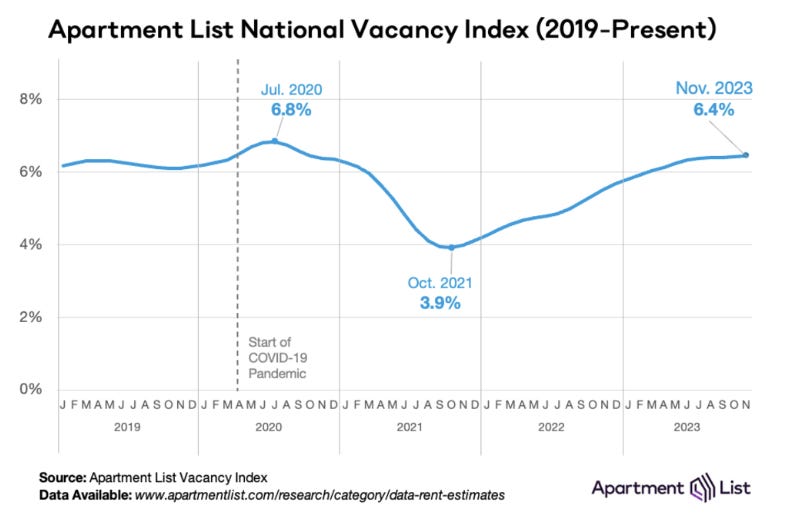Asking Rents Down 1.1% Year-over-year
Tracking rents is important for understanding the dynamics of the housing market. For example, the sharp increase in rents helped me deduce that there was a surge in household formation in 2021 (See from September 2021: Household Formation Drives Housing Demand).
The surge in household formation has been confirmed (mostly due to work-from-home), and this led to the supposition that household formation would slow sharply in 2023 (mostly confirmed) and that asking rents might decrease in 2023 on a year-over-year basis (now negative year-over-year).
Recent data suggests household formation has slowed sharply and asking rents are declining year-over-year. With a near record number of multi-family units under construction, slow household formation, rising vacancy rates, and soft rents, most builders expect to start fewer multi-family units in 2024.
First, a survey of rent reports …
Apartment List: Asking Rent Growth -1.1% Year-over-year
From ApartmentList.com: Apartment List National Rent Report
Welcome to the December 2023 Apartment List National Rent Report. The rental market’s seasonal slowdown continued this month, with the nationwide median rent falling 0.9 percent to $1,340. This marks the fourth consecutive month of negative rent growth, and low apartment demand during the winter holiday season will likely continue to push rents down for another month or two.
Year-over-year rent growth has bottomed out but remains in negative territory at -1.1 percent, meaning that on average, apartments across the country are slightly cheaper today than they were one year ago. This stands in sharp contrast to the prevailing conditions of 2021 and 2022, when rent prices were surging and year-over-year growth peaked at 18 percent nationally. But despite this cooldown, the national median rent is still nearly $250 per month higher than it was just three years ago. …
This is the second steepest November rent decline that we’ve seen in the history of our index (going back to 2017). The only time that November brought a sharper decline was last year, when rents fell by 1.1 percent as the market shifted into the period of sluggishness that still persists. For comparison, from 2017 to 2020, November declines averaged 0.5 percent.
On a year-over-year basis, rents nationally are down 1.1 percent. Year-over-year rent growth fell to zero in June for the first time since the early stages of the pandemic, and has now been in negative territory for five consecutive months. Seasonal trends suggest that monthly rents will continue to dip through the remainder of the calendar year, before we see a potential rebound in early 2024. …
[A]fter bottoming out in October 2021, our national vacancy index has been easing steadily for two full years. Today the index stands at 6.4 percent, representing a return to pre-pandemic levels. This easing has plateaued in recent months, but we don’t expect it to tighten again anytime soon.…
emphasis added
Realtor.com: Sixth Consecutive Month with Year-over-year Decline in Rent
From Realtor.com: October 2023 Rental Report: Rents Continue to Decline
In October 2023, the U.S. median rent continued to see a year-over-year decline for the sixth month in a row, down -0.5% for 0-2 bedroom properties across the top 50 metros, a pace slightly slower than the -0.7% seen in September. The median asking rent was $1,729, down by $18 from last month and $47 less from the peak seen in July 2022. However, it was still $326 (23.2%) higher than the same time in 2019 (pre-pandemic).
CoreLogic: “17th consecutive month” of Deceleration
CoreLogic also tracks rents for single family homes: US Annual Rent Growth Relaxes for the 17th Straight Month in September, CoreLogic Reports
Annual U.S. single-family rent growth dropped to the lowest level in three years in September, but the 2.6% increase is down only slightly from the pre-pandemic average. …
“Single-family rent growth eased again in September and is now back to the rate recorded before the pandemic,” said Molly Boesel, principal economist for CoreLogic. “While low-tier rental gains are slowing, they have still surpassed those of their higher-priced counterparts since early 2020. Slowing month-over-month rent growth in September reflects typical seasonal patterns, but indications are that annual gains will remain positive through the rest of 2023.”
The 2.6% YoY increase in September was down from 2.9% in August.
Real Page: Year-over-year “held steady at a flat 0.1% annually or a second consecutive month in October”
From Jay Parsons at Real Page: After Rapid Cooldown, Apartment Rents Plateau (For Now)
For the first time in three years, the year-over-year apartment rent growth trendline isn’t moving like a roller coaster. National rent growth held steady at a flat 0.1% annually for a second consecutive month in October – pushing the pause button on what had been 18 straight months of cooling that followed a similar stretch of increases.
Rent Data
Here is a graph of several measures of rent since 2000: OER, rent of primary residence, Zillow Observed Rent Index (ZORI), ApartmentList.com and CoreLogic Single Family Rental Index (All set to 100 in January 2017)
Keep reading with a 7-day free trial
Subscribe to CalculatedRisk Newsletter to keep reading this post and get 7 days of free access to the full post archives.








